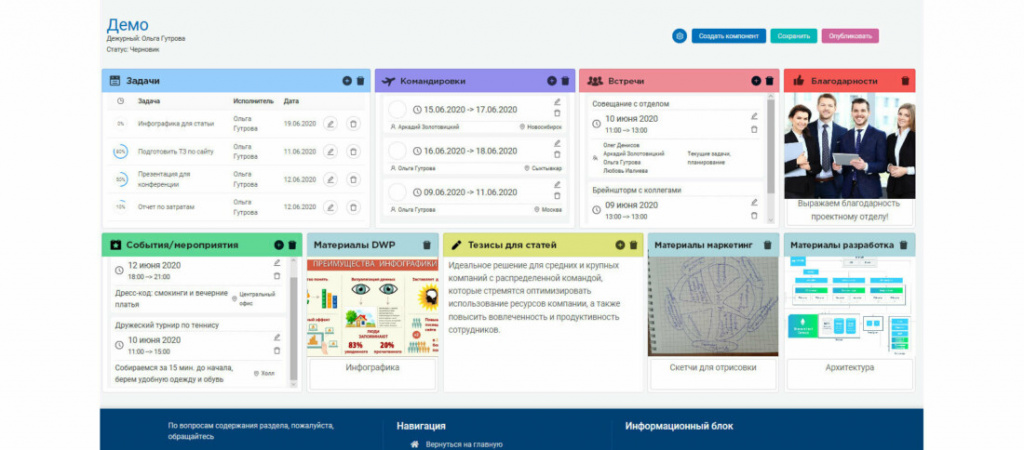Companies that strive to be at the forefront of digitalization have long been talking about the need to create a digital workplaces (DWP). The latest events related to the pandemic and the total transfer of employees to remote work showed us the inevitability of such a transition. After all, we all understand that there may be a second wave of the epidemic, and a completely different type of virus. Businessmen cannot make the financial well-being of their companies depend on such force majeure. Moreover, there is already a reasonable and tested way to reduce such risks.
Digital Workplaces enable large and midsize companies to consolidate all of their internal and external digital operations on a common platform into a single coherent strategy, regardless of the physical location of employees. And this is another factor in the retention and development of talent within the company. Digital workplace (DWP) expands the geography of hiring and allows you to select the highest quality workforce without relocating them. In addition to the effective transfer of employees to remote work, there are other tasks that the implementation of DWP successfully solves, namely:
-
automation of routine processes;
-
creation of a unified working environment with collaboration tools;
-
optimization of time costs;
-
increasing employee efficiency and engagement;
-
creation of a knowledge base with various types of corporate data: documents, reference books, media materials.
During the quarantine period, IT and telecom companies turned out to be the most prepared for a quick and massive transition to remote operation, because they had the practice of remote work even before the crisis:
MOSCOW, June 8. / TASS /. Russian telecom and IT companies are considering various options for returning to offices after the restrictions have been lifted due to the pandemic - up to and including the transfer of most employees to permanent remote work.
Of course, flexible workplaces and mobility of employees significantly increase the company's adaptability in any conditions, reduces its sensitivity to external factors. In addition, many companies have found economic incentives in this regime. “The main advantages of remote work for an employer are savings in office rent and office maintenance, as well as the ability to hire talented employees from any regions.
The Digital workplace concept initially focuses on user friendliness and organization of a comfortable work environment, but strategically plays for the interests of the company.
This idea is also confirmed by the companies themselves, which are planning to implement digital workplaces:
“When we asked teams to describe their top priorities for digital workplaces, we were not particularly surprised by the three main responses: digitization and process improvement; knowledge management; culture and changes. However, we were quite surprised by the fourth most popular priority, ”improving customer service.” We felt that this was part of a growing trend in recognizing a clear link between employee and customer experiences, and how the digital workplace can provide better experience and service that is felt by the outsider” (Digital workplace group).
It turns out that the management of companies see a direct connection between the implementation of digital workplaces and the quality of customer service. Indeed, there are many clear examples of how the digital workplace can improve the customer experience, including through:
-
supporting employees with specific information about customers, usually through a CRM system;
-
providing employees with up-to-date information about products and services, for example, through knowledge bases for contact center employees, which allows faster problem solving;
-
Providing collaboration solutions that enable diverse or distributed teams to work together effectively to provide more coordinated customer service and the development of new products and services;
-
automation of routine processes for faster delivery of services;
-
collecting customer data to help us improve and improve the product;
-
creating a more flexible workforce that can respond more quickly to the external environment;
-
supporting a happier, more energetic and motivating work environment that impacts the customer experience, especially in sensitive areas such as retail.
The trend to create digital jobs not only among back office workers, but also front office workers has recently been very successfully supported by Microsoft. In early 2019, Microsoft released a new version of the corporate messenger Teams, where the new functionality was aimed at firstline workers who are responsible for communicating with customers. Usually they do not work in an office and they do not have their own workplace, and often even a computer. Thus, Teams immediately covered the needs of the organization at all levels: front office (waiters, salespeople, consultants, couriers, cashiers), middle office (administrative and management personnel) and back office (human resources, accounting, logistics, technical personnel, postal and warehouse departments, IT - department). Teams also forms around itself an ecosystem of services that ensure the full operation of the business. It perfectly integrates with CRM, ERP, chatbot, workflow system, service desk, knowledge base and corporate portal.
What do these digital workplaces look like? In terms of content, this is a common workspace, and in terms of form, it is a necessary set of widgets, customized for each user.
A working dashboard might look like this:

For many years, our company has been implementing internal corporate portals and personal accounts based on these portals, and with the release of Teams, it began to develop this direction towards the digital workplace. SystemZ's experience shows that DWP is the ideal solution for mid-sized and large companies with a distributed team looking to optimize the use of company resources and increase employee engagement and productivity. At the same time, it is very important when implementing the DWP concept to correctly assess the level of the corporation's readiness for digital changes.
The site uses cookies. By visiting the site, you agree to the Privacy Policy and the processing of personal data of site users.
{{okmessage}}
{{errSessid}}
{{globalErrorText}}
